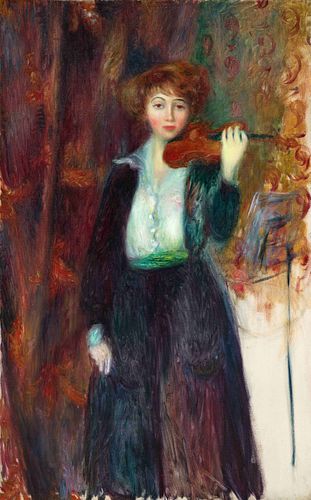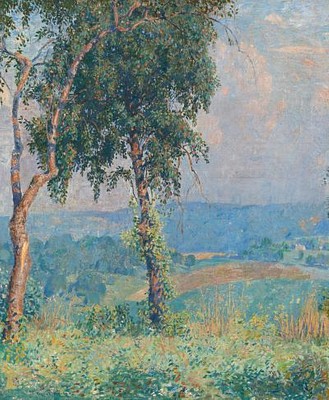William Glackens(American, 1870-1938)Girl with Violin, c. 1917
Lot 37
About Seller
Hindman
1338 West Lake Street
Chicago, IL 60607
United States
Recognized as the Midwest's leading fine art auctioneers, Hindman Auctioneers has built a worldwide reputation based on a full service approach to the auction business tailored to meet the individual needs of our clients. Coming from a variety of educational backgrounds, specialists bring years of e...Read more
Estimate:
$70,000 - $90,000
Absentee vs Live bid
Two ways to bid:
- Leave a max absentee bid and the platform will bid on your behalf up to your maximum bid during the live auction.
- Bid live during the auction and your bids will be submitted real-time to the auctioneer.
Bid Increments
| Price | Bid Increment |
|---|---|
| $0 | $25 |
| $500 | $50 |
| $1,000 | $100 |
| $2,000 | $250 |
| $5,000 | $500 |
| $10,000 | $1,000 |
| $20,000 | $2,500 |
| $50,000 | $5,000 |
| $100,000 | $10,000 |
About Auction
By Hindman
May 3, 2021
Set Reminder
2021-05-03 11:00:00
2021-05-03 11:00:00
America/New_York
Bidsquare
Bidsquare : American & European Art
https://www.bidsquare.com/auctions/hindman-auctions/american-european-art-6794
Hindman Bidsquare@hindmanauctions.com
Hindman Bidsquare@hindmanauctions.com
- Lot Description
William Glackens
(American, 1870-1938)
Girl with Violin, c. 1917
oil on canvas
48 x 30 inches.
Provenance:
Kraushaar Galleries, New York
Acquired directly from the above by the present owners, 1988
Exhibited:
Atlanta, Georgia, High Museum of Art, Georgia Collects, January 24 - May 26, 1989
Athens, Georgia, University of Georgia, Georgia Museum of Art, American Impressionism in Georgia Collections, September 11 - November 14, 1993 (also traveled to Charlotte, North Carolina, Mint Museum of Art, April 16 - June 19, 1994)
Auburn, Alabama, Auburn University, The Jule Collins Smith Museum of Art, Auburn Collects: The Noel and Kathryn Dickinson Wadsworth Collection, March 13 - May 21, 2004, pl. 16, pp. 33-35, illus.
Property from the Collection of Noel and Kathryn Dickinson Wadsworth, Atlanta, Georgia
Literature: Vincent John de Gregorio, The Life and Art of William J. Glackens, PhD dissertation, Ohio State University, 1955, vol. 1, p. 451, no. 46
Lot essay:
Originally associated with the Ashcan School of artists, William Glackens came to be known as an American Impressionist and was compared to Manet and Degas by contemporary critics. Although Glackens closely interacted with Robert Henri and the Ashcan crowd—studying, sharing studio space, and traveling with them—he was drawn less to the rough, urban scenes and more to scenes of recreation and entertainment. He depicted the real but chose more ebullient themes than most of his friend from Philadelphia and the “Charcoal Club.” Art historian William H. Gerdts claims that Glackens exhibited a “commitment to the theme of urban and suburban pleasure grounds,” frequently depicting parks, gardens, beaches, dance halls, festivals, theatres, restaurants, and family gatherings.
In 1895 Glackens joined mentor Henri on a 15-month sojourn to Europe. He continued to travel throughout his career to the Continent, often visiting Paris. It was here that the artist found inspiration in the art of the French Impressionists, particularly in the paintings of Pierre-Auguste Renoir. The first-hand exposure to Renoir’s work had a profound effect on Glackens' approach to color, and the artist adopted a vivid palette with contrasting harmonies.
By the 1910s, the artist became known as a “figure specialist,” moving away from his earlier, populated landscapes, seascapes, and urban vistas, and concentrating more on individuals. Glackens did not intend these paintings as portraits, although he used specific models; the titles, such as Girl with Violin, affirm the ambiguity that he desired in these images. Noel Wadsworth, the present owner of this artwork, recounts a conversation that he had with Ira Glackens, the artist’s son: “Ira remembers the model for Girl with Violin. She frequently posed for William Glackens when Ira was a child, and she actually played the violin.”
In addition to this shift in subject matter, Glackens intensified his approach to light and color, revealing the continued influence of Renoir. Girl with Violin reflects his new preoccupation with individuals and colorism, while still referencing his interest in leisure and entertainment. Infused with jewel-like greens and contrasting deep reds, the painting presents the unidentified musician as if about to begin to play, her bow not yet in her hand. She raises her eyebrows laconically, as if to command a respectful silence from her audience. The work is representative of Glackens’ impressionistic approach, with its broad, feathery brushwork and interest in entertainment as subject matter.For condition inquiries please contact marygracebilby@hindmanauctions.comCondition
- Shipping Info
-
Please refer to https://hindmanauctions.com/shipping-packing
-
- Buyer's Premium



 EUR
EUR CAD
CAD AUD
AUD GBP
GBP MXN
MXN HKD
HKD CNY
CNY MYR
MYR SEK
SEK SGD
SGD CHF
CHF THB
THB











